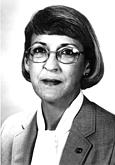Lana M. Couch
For her outstanding achievement and vision in leading NASA's development of hypersonic and transatmospheric flight, the Schools of Engineering are proud to present the Distinguished Engineering Alumna Award to Lana M. Couch.
Director, National Aero-Space Plane Office
NASA Langley Research Center
BSAAE 1963

On aeronautical engineering and Purdue
In high school I had a strong interest in both mathematics and science. I was a fan of books on airplanes and rocket systems, even of science fiction. It was a natural evolution to proceed to aeronautical engineering. I received strong encouragement from my parents and teachers.
As a college student I was fairly intense and serious. At that time money was quite scarce for a lot of people in rural Indiana-I grew up near Martinsville-and most of the people who were lucky enough to be able to go to college were very focused on studies.
I participated in the amateur radio club, the American Society of Mechanical Engineers, the American Rocket Society, and the Society of Women Engineers. I was also on student staff at my dormitory. I found the curriculum at Purdue to be quite challenging. There were well-established study groups for students who were in fraternities and some cooperative houses. That was not true for the women studying engineering. There were only a few of us, but we did try to help each other where we could. Two women graduated in aeronautical engineering in my senior year. When I came back to Purdue in 1990 to speak at a Society of Women Engineers banquet, I was amazed at the number of women engineers. The progress was absolutely wonderful. The enthusiasm and interest were high, and the students were very secure and confident.
A number of people at Purdue were outstanding advisers. Professor Cargnino was very helpful throughout my four years. Professor Gustafson taught the first course I had on boundary layer flow. I found that to be extremely interesting and went on to concentrate on that area of fluid mechanics, in combination with heat transfer, in my research at NASA.
On her career
As a student I was most interested in experimental research using wind tunnels to generate data on airplanes and rockets. My goal was to work for NASA. When I was lucky enough to be offered a job by NASA, I accepted it immediately.
I was committed to experimental research-that was a fine goal, to do that and do it well. After twelve years as a researcher, I had the opportunity to move into a supervisory role and have since proceeded into management. I would never have suspected that my career would take the route that it has. It has been quite varied-satisfying, very interesting, and difficult at times. It has included work in both aeronautics and space technology and in program management at the national level and on both civilian and military technology programs. I also spent one and a half years on the U.S. Senate staff with the Commerce, Science, and Technology Committee.
Now I lead the NASA technical development of the technology for a single-stage-to-orbit airplane that will someday take off from a runway, fly into orbit, and return to land on a runway.
On change
We are in the process of change in this country. The National Performance Review is helping government examine how it does business, who its customers are, and how it can work more closely with them. We're trying to make government activities more effective. The number of people involved will decrease, and the number of dollars will probably decrease. We're challenged to find ways to do our work more efficiently but still maintain productivity and timeliness.
Much of the focus in the U.S. aerospace community has been on developing systems or technologies initially for military applications, such as very high performance airplanes, and then applying the technology to civilian needs. With the military downsizing, the primary emphasis is shifting to the civilian and commercial sectors. This shift of emphasis is changing the content of government-funded research and technology programs. In some cases, it is lowering the significance of some traditionally prominent technologies and placing more emphasis and resources on technologies that contribute directly to the commercial competitiveness of U.S. aerospace products. This change may also have major potential implications for the content of engineering curricula in the future.
- 1993:
- Senior Executive Service Presidential Rank Award.
- 1993:
- Women in Aerospace's Lifetime Achievement Award.
- 1992:
- NASA Exceptional Achievement Medal.
- 1990:
- Director, National Aero-Space Plane Office, NASA Langley Research Center. Leads the NASA technical development of technology for an air-breathing-engine-powered airplane capable of flying to orbit.
- 1990:
- Keynote speaker, Society of Women Engineers Award Luncheon, Purdue.
- 1989:
- Women in Aerospace's Apollo 20th Anniversary Award.
- 1988:
- Acting director, Space Research and Technology Program.
- 1987:
- Congressional fellowship, U.S. Senate Commerce, Science, and Technology Committee. Advocated NASA' s Wind Tunnel Revitalization Program and a new technology development program for supersonic transport aircraft.
- 1986, 1988:
- National Aviation Club's Women in Aviation Award.
- 1986:
- NASA Exceptional Service Medal.
- 1985:
- Manager, NASA/DOD National Aero-Space Plane Program and Hypersonics.
- 1983:
- Manager, Spacecraft Systems Technology and In-Space Technology Experiments.
- 1980:
- Program manager, Fluid and Thermal Physics, NASA Headquarters.
- 1978:
- Assistant head, Thermal Tunnels Branch.
- 1975:
- Head, Structural Tunnels Section. Modified 8-foot high-temperature tunnel for testing hypersonic vehicle propulsion systems.
- 1963:
- Research engineer, NASA Langley Research Center.
BSAAE 1963, Purdue.
